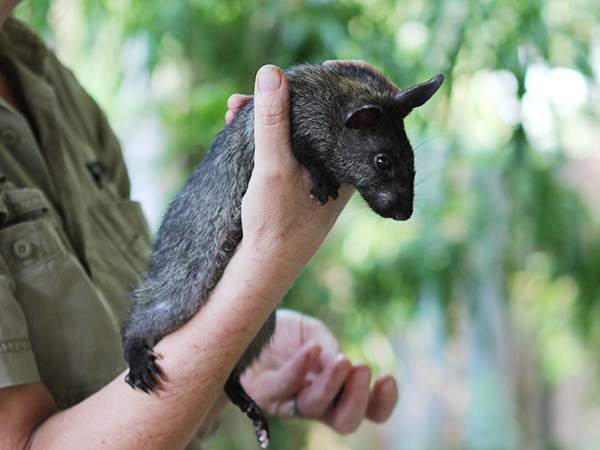Community backing project
By Greening Australia
Darwin rural landholders have thrown their support behind a Greening Australia project to create new homes and food sources for the endangered black-footed tree-rat in the Northern Territory.
The collaborative project, delivered through Land for Wildlife Top End with $25,000 funding from Territory NRM, has seen 145 nest boxes installed and over 1,500 plants established to create more habitat and provide critical food sources for the rodent and other tree-dwelling mammals.

The endangered black-footed tree-rat found in the Northern Territory.
The nocturnal black-footed tree-rat, which is the size of a small rabbit and sports a white-tipped tail, is one of Australia’s largest rodents. It relies on tree hollows for nesting during the day and foraging at night. Populations are found scattered around the Top End including the greater Darwin area.
Community engagement and awareness have formed a core role in the project to ensure landholders are familiar with the species and its needs.
Greening Australia project officer Emma Lupin is passionate about the Territory native landscape and particularly the importance of the interaction between flora and fauna species. She enthusiastically engages with like-minded landholders who voluntarily manage their properties to promote wildlife habitat.
Emma said the project had been a very successful partnership between landholders, the community, the Territory Wildlife Park and other stakeholders.
“Through the project we’ve been able to engage local landholders to teach them ways to help black-footed tree-rats. The success of the project has exceeded our expectations,” Emma said.
“It was important for us to educate landholders and the community about this threatened species and encourage them to assist in their protection by getting them to report sightings and teaching people to spot the difference between native tree-rats and pest rats,” Emma said.
“By increasing the availability of nesting locations by installing nest boxes on their properties, providing mid-storey fruiting trees to increase the availability of food, managing fires and retaining hollow logs and native grasses, landholders can play a critical role in securing the future of Darwin’s native tree-rats.”
The project targeted private properties in rural Darwin and surrounding areas that were already being managed for conservation under Land for Wildlife Top End.

The nesting boxes were all constructed by the Palmerston’s men shed.
Emma said 29 landholders from 29 properties had joined the program along with three local primary schools – Girraween Primary, Howard Springs Primary School and Milkwood Steiner School.
“There has been a lot of enthusiasm for the project and it was a fantastic opportunity to collect data and to engage the community from adults through to school children, to promote wildlife management and awareness,” Emma said.
“We hosted an education event for the local community at Territory Wildlife Park with presentations on tree-dwelling mammals and an interactive display by Remote Area Tree Services on the use of dead timber as nesting hollows or ground habitat. It was also a chance for landholders to learn about installing nest boxes and get hands-on with painting the new homes for the rats.”
“The highlight of the day though was the opportunity to see and interact with various native animals including a black-footed tree-rat, sugar glider, and northern quoll.”
“The project is going exceptionally well with nest boxes established at all 29 properties; these were all constructed by the Palmerston’s men shed and designed by us based on the findings of Charles Darwin University researcher Leigh-Ann Woolley, so it really is very much a community-owned and led project.”
The team will continue to work with Territory NRM to monitor the success of the project through ongoing data collection.
A new Northern Territory Environment Grant is facilitating further community engagement, installation of nest boxes and camera trapping which will provide valuable new sightings data for the Northern Territory WildWatch program.
Any Top End rural landholders interested in participating in the program can call project officer Emma Lupin on 08 7922 9500 or email [email protected].
You can also apply for program membership or keep up-to-date with all program activities and landholder stories at https://landforwildlifetopend.com/become-a-member/



